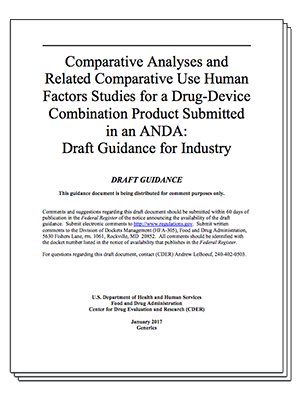Human Factor’s role in the FDA’s latest guidelines on combination product device development
By Michael Lau, PhD, Director of Human Factors
How the new FDA draft guidance for combination products submitted in an Abbreviated New Drug Application (ANDA) affects your device development strategy

The FDA recently released a new draft guidance entitled, “Comparative Analyses and Related Comparative Use Human Factors Studies for a Drug-Device Combination Product Submitted in an ANDA: Draft Guidance for Industry”.
Key Points of the Guidance
This guidance offers clarity on the consideration of human factors when developing a generic combination product. Specifically, it advises using threshold analyses to identify whether there are any differences in the user interface between the proposed generic product and the reference listed drug (RLD). In the event that design differences are identified, the applicant must demonstrate through comparative human factors studies that the safety profile of the new user interface is equivalent or better than the RLD. That is, the use error rate associated with a change in any external critical design attribute is at least no greater for the proposed product compared to the RLD.
The major implication for companies developing products for an ANDA submission is that it is important to consider human factors of the user interface and to minimize differences from the RLD at the very onset of the device constituent development, whether it be for the i) selection of a platform device or ii) custom development of a device. Failure to consider the risks inherent with any differences could lead to costly comparative studies and/or preclusion of approval in an ANDA. These costs and risks can be minimized by eliminating differences between the user interfaces from the onset.
Selection of a platform device
It is important to consider the risks of use-related hazards with the RLD and its intended user population prior to selecting a platform device. Understanding the human factors demands that the RLD places on the user can help identify a suitable, similar device from a list of potential platform devices. Failure to consider the human factors may jeopardize development. For example, failure to consider the needle safety system during the selection of a pre-filled syringe intended for use by a caregiver may lead to use errors caused by negative transfer if one with an active system is selected instead of a passive one employed by the RLD. In turn, this could require selection of a different platform device.
Custom development of a device

Aside from the obvious challenges of custom development, there are additional hurdles that may affect the user interface when this approach is taken. For instance, circumnavigating existing intellectual property or trade dress may introduce design differences to the user interface. By understanding the workflow and use-related hazards of the RLD, different solutions to solve for these problems may be found if it is clear from the onset to the device designers which are the critical attributes that must be preserved. For example, grip patterns on a injection device that have been trademarked could be replaced with different grip features in a custom device provided that the new device affords a similar level of grip security to accomplish the intended use.
Comparative Human Factors Studies
The burden of conducting comparative human factors studies is significant and should be avoided if possible. Comparative human factors studies differ from typical formative and validation studies in that they are used to compare two products instead of evaluating the usability of a single one. They are not intended to replace validation studies. Comparative studies will likely require larger participant sample sizes (the guidance gives examples with n=45 and greater), lengthen development timelines, and use a significant amount of prototype and RLD devices. Finally, these studies do not guarantee that the proposed device will be found to be an acceptable substitution for the RLD device.
Plan and Conduct Human Factors Activities Early
Development of a plan to navigate these important device constituent issues is founded on an in-depth understanding of user needs and critical design attributes. A strategic approach to ensure that the human factors associated with the RLD are appropriately considered at the beginning of device selection and/or development of a generic combination product is warranted to prevent unnecessary development delays or complications.
Check out additional Human Factors article
by Michael Lau:
Why do Human Factors Engineering?
Why Making an Easy-to-Use Solution is Not So Easy
